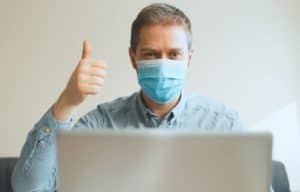
As you reopen, or ramp up the volume of patients you see, you must have a specific plan in place to continuously keep your patients and staff safe. Doing so hinges on your ability to maintain a sufficient supply of personal protective equipment (PPE), but due to the COVID-19 supply chain disruptions attaining this supplies can still be a significant challenge.
There are actions you can take to alleviate your supply pressures so you can safely treat more patients.
#1: Explore Alternatives
To start, it’s important that you take a complete inventory of the supplies you currently have on hand, then consider these options for acquiring your supply of masks and gowns.
As you begin to reopen your practice doors to higher patient volume, you need masks, gloves, respirators, and other PPE to see patients at your practice. Take inventory so you know what you have on hand, then consider these options for acquiring your supply of masks and gowns.
- Reach out to your community. Nothing rallies a community together like a crisis. Post a message on your Facebook page indicating your PPE shortage and reach out for donations. Local companies are stepping up across the nation to donate PPE supplies to healthcare workers.
- Request supplies. Submit a donation request form on GetUsPPE.org, a grassroots organization working to get healthcare workers PPE. You can also connect with your state representative’s office to send a message regarding their assistance with providing healthcare workers with PPE.
- Contact your state officials. Some states like New York and Pennsylvania have been sharing resources between hospitals. If your healthcare facility is in dire need, consider reaching out to your state governor, state office for the Department of Homeland Security, or your local representatives.
- Allow homemade PPE. If you are facing a PPE shortage, the American Medical Association supports allowing your staff to wear homemade masks and respirators.
- Use alternate suppliers. When the supply chain is flowing, be cautious not to put all of your proverbial eggs in one basket. Some distributors fulfill large organization allocation orders on priority delaying smaller order distribution. Use multiple vendors to spread your risk
#2: Look to CDC For Guidance
The Centers for Disease Control (CDC) offers strategies to optimize your PPE when your supplies are stressed, running low, or absent. Implement these strategies when you have supplies but anticipate a difficult time acquiring more:
- Reuse supplies: Cloths gowns not used in a sterile field can be reused if laundered in enzymatic detergent.
- Use expired gowns and masks. You may use these beyond the supply’s shelf life or expiration date. The FDA believes they still offer some protection. Check for no visible damage.
- Switch to reusable supplies: Consider changing to reusable supplies such as googles, re-usable face shields instead of single-use supplies. Make sure to clean and disinfect supplies between users.
- Increase air sterilization: Maximize use of engineering controls, such as barriers and maintained ventilation systems, and administrative controls, such as altering work practices to minimize patient contacts.
- Limit offerings: Cancel elective and non-urgent procedures/appointments.
#3—Be Good Stewards of Your PPE
Ideally, all of your patients and staff should wear a mask but that might not be feasible. In this situation, here are tips to help you conserve your resources.
- Limit supplies: If you’ve facing a shortage, the CDC recommends you limit your masks to just your healthcare workers and have patients with respiratory symptoms use tissues or other barriers to cover their mouth and nose. You can also use the same mask for more than one patient visit providing it isn’t soiled, damaged, or difficult to breathe through.
- Continue virtual services: Using telemedicine to see patients is one way to reduce your overall need for PPE. You don’t need gloves or a mask when seeing a patient electronically. Fewer patients in the office also means fewer masks needed for patients and support persons.
- Need other ideas? The JAMA Network posted a call for ideas on how to conserve PPE which has garnered a lot of replies.
Acquiring the necessary PPE is just one of the many COVID-19 challenges you face, and infectious disease practitioner, Javeed Siddiqui, MD, and practice management expert consultant and trainer, Owen Dahl, MBA, LFACHE, CHBC, LSSMBB, can help. In their no-cost online training session, Dr. Siddiqui and Mr. Dahl will provide you with practice-specific strategies you can implement to survive the day-to-day challenges associated with COVID-19.



